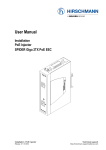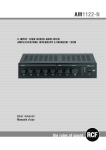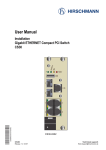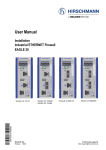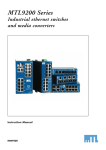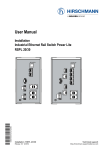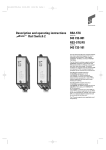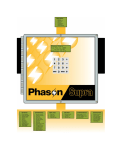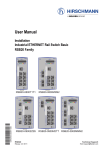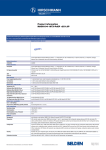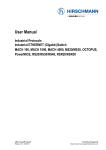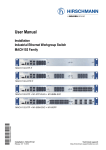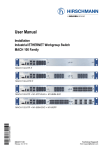Download User Manual Installation, SPIDER II 16TX EEC, SPIDER II 16TX/2DS
Transcript
User Manual Installation Industrial Ethernet Rail Switch SPIDER II 16TX EEC, SPIDER II 16TX/2DS-S EEC SPIDER II 16TX EEC Installation SPIDER II 16TX Release 01 05/2014 SPIDER II 16TX/2DS-S EEC Technical Support https://hirschmann-support.belden.eu.com The naming of copyrighted trademarks in this manual, even when not specially indicated, should not be taken to mean that these names may be considered as free in the sense of the trademark and tradename protection law and hence that they may be freely used by anyone. © 2014 Hirschmann Automation and Control GmbH Manuals and software are protected by copyright. All rights reserved. The copying, reproduction, translation, conversion into any electronic medium or machine scannable form is not permitted, either in whole or in part. An exception is the preparation of a backup copy of the software for your own use. For devices with embedded software, the end-user license agreement on the enclosed CD/DVD applies. The performance features described here are binding only if they have been expressly agreed when the contract was made. This document was produced by Hirschmann Automation and Control GmbH according to the best of the company's knowledge. Hirschmann reserves the right to change the contents of this document without prior notice. Hirschmann can give no guarantee in respect of the correctness or accuracy of the information in this document. Hirschmann can accept no responsibility for damages, resulting from the use of the network components or the associated operating software. In addition, we refer to the conditions of use specified in the license contract. You can get the latest version of this manual on the Internet at the Hirschmann product site (www.hirschmann.com). Printed in China Hirschmann Automation and Control GmbH Stuttgarter Str. 45-51 72654 Neckartenzlingen Germany Tel.: +49 1805 141538 Installation SPIDER II 16TX Contents Safety instructions 4 About this Manual 8 Legend 8 1 Description 9 1.1 General device description 9 1.2 Description of the device variants 9 1.3 Ethernet ports 1.3.1 10/100 Mbit/s twisted pair port 1.3.2 100/1000 Mbit/s F/O port (optional) 10 10 11 1.4 Display elements 12 2 Installation 13 2.1 Unpacking and checking the content of the package 13 2.2 Installing and grounding the device 2.2.1 Installing the device onto the DIN rail 2.2.2 Grounding the device 13 13 14 2.3 Wiring the terminal block for the working voltage and grounding 15 2.4 Operating the device 16 2.5 Connecting data cables 16 2.6 Installing an SFP transceiver (optional) 17 2.7 Removing the SFP transceivers 17 3 Maintenance and service 18 4 Disassembly 19 4.1 Removing the device from the DIN rail 19 5 Technical data 20 A Further Support 26 Installation SPIDER II 16TX Release 01 05/2014 3 Safety instructions General safety instructions You operate this device with electricity. Improper usage of the device entails the hazard of physical injury or significant damage to property. Before connecting any cable, read this document, and the safety instructions and warnings. See “Operating voltage” on page 5. The proper and safe operation of this device depends on proper handling during transportation, proper storage and assembly, and conscientious operation and maintenance procedures. Operate the device with undamaged components exclusively. Qualification requirements for personnel Only allow qualified personnel to work on the device. Qualified personnel have the following characteristics: Qualified personnel are properly trained. Training as well as practical knowledge and experience make up their qualifications. This is the prerequisite for grounding and labeling circuits, devices, and systems in accordance with current standards in safety technology. Qualified personnel are aware of the dangers that exist in their work. Qualified personnel are familiar with appropriate measures against these hazards in order to reduce the risk for themselves and others. Qualified personnel receive training on a regular basis. Certified usage Use the device solely for the application cases described in the Hirschmann product information, including this manual. Operate the device solely according to the technical specifications. See “Technical data” on page 20. National and international safety regulations Verify that the electrical installation meets local or nationally applicable safety regulations. 4 Installation SPIDER II 16TX Release 01 05/2014 Operating voltage The working voltage is electrically isolated from the housing. Ground the device before connecting any other cables. Connect solely an working voltage that corresponds to the type plate of your device. Every time you connect the electrical conductors, make sure that the following requirements are met: The voltage supply has an easily accessible disconnecting device (e.g. a switch or a plug). This disconnecting device is clearly identified. So in the case of an emergency, it is clear which disconnecting device belongs to which line. The electrical wires are voltage-free. Relevant for North America: The power supply is Class 2 compliant. The working voltage inputs are designed for operation with safety extra-low voltage. Connect solely SELV circuits with voltage restrictions in line with IEC/EN 60950-1 to the working voltage connections. A fuse suitable for DC voltage is located in the plus conductor of the power supply. Regarding the properties of this fuse: See “General technical data” on page 20. The wire diameter of the power supply cable is at least 1 mm² (North America: AWG16) on the working voltage input. The power supply cables used are permitted for the temperature range required by the use case. Relevant for North America: For use in Class 2 circuits Use copper wire/conductors of class 1 60/75 °C or 75 °C or 90 °C exclusively. Start connecting the electrical wires solely if all the above requirements are fulfilled. The device is free of any service components. Internal fuses are triggered solely in the case of a detected fault in the device. In case of damage or malfunction of the device, turn off the operating voltage and return the device to the plant for inspection. Installation site requirements Verify that there is at least 4 in (10 cm) of space above and below the device. Verify that there is at least 0.8 in (2 cm) of space on the right and left sides of the device. Installation SPIDER II 16TX Release 01 05/2014 5 Housing Only technicians authorized by the manufacturer are permitted to open the housing. Never insert pointed objects (narrow screwdrivers, wires, etc.) into the device or into the connection terminals for electric conductors. Do not touch the connection terminals. Verify that the electrical installation meets locally or nationally applicable safety regulations. Keep the ventilation slits free to ensure good air circulation. Install the device in the vertical position. At ambient temperatures > 140 °F (60 °C): The surfaces of the device housing may become hot. Avoid touching the device while it is operating. LED or laser components Relevant for SPIDER II 16TX/2DS-S EEC: LED or LASER components according to IEC 60825-1 (2007): CLASS 1 LASER PRODUCT CLASS 1 LED PRODUCT CE marking The labeled devices comply with the regulations contained in the following European directive(s): 2011/65/EU (RoHS) Directive of the European Parliament and of the Council on the restriction of the use of certain hazardous substances in electrical and electronic equipment. 2004/108/EC (EMC) Directive of the European Parliament and the council for standardizing the regulations of member states with regard to electromagnetic compatibility. In accordance with the above-named EU directive(s), the EU conformity declaration will be at the disposal of the relevant authorities at the following address: Hirschmann Automation and Control GmbH Stuttgarter Str. 45-51 72654 Neckartenzlingen Germany Tel.: +49 1805 141538 The device can be used in the industrial sector. Interference immunity: EN 61000-6-2 Emitted interference: EN 61000-6-4 6 Installation SPIDER II 16TX Release 01 05/2014 Warning! This is a class A device. This device can cause interference in living areas, and in this case the operator may be required to take appropriate measures. Note: The assembly guidelines provided in these instructions must be strictly adhered to in order to observe the EMC threshold values. FCC note This device complies with part 15 of the FCC rules. Operation is subject to the following two conditions: (1) this device may not cause harmful interference; (2) this device must accept any interference received, including interference that may cause undesired operation. Appropriate testing has established that this device fulfills the requirements of a class A digital device in line with part 15 of the FCC regulations. These requirements are designed to provide sufficient protection against interference when the device is being used in a business environment. The device creates and uses high frequencies and can also radiate high frequencies, and if it is not installed and used in accordance with this operating manual, it can cause radio transmission interference. The use of this device in a living area can also cause interference, and in this case the user is obliged to cover the costs of removing the interference. Recycling note After usage, this device must be disposed of properly as electronic waste, in accordance with the current disposal regulations of your county, state, and country. Installation SPIDER II 16TX Release 01 05/2014 7 About this Manual The “Installation User Manual” document contains a device description, safety instructions, a display description and other information that you require to install the device before starting with the configuration of the device. Legend The symbols used in this manual have the following meanings: 8 Listing Work step Subheading Installation SPIDER II 16TX Release 01 05/2014 1 Description 1.1 General device description The SPIDER II 16TX devices are designed for the special requirements of industrial automation. They meet the relevant industry standards, provide very high operational reliability, even under extreme conditions, and also long-term reliability and flexibility. The devices allow you to set up switched industrial Ethernet networks that conform to the IEEE 802.3 standard. The device is mounted by latching in place on a hat rail. The devices work without a fan. You have the option of choosing various media to connect to the terminal devices and other network components: twisted pair cable multimode F/O singlemode F/O The Hirschmann network components help you ensure continuous communication across all levels of the company. 1.2 Description of the device variants The devices differ with regard to the number of interfaces and the media type for connecting segments. The table below shows the number and type of ports for each device variant. The abbreviations F/O (fiber optic) and TP (twisted pair) indicate the media type. The abbreviations SFP and RJ45 indicate the socket type. Variant SPIDER II 16TX EEC SPIDER II 16TX/2DS-S EEC Table 1: RJ45 socket for 10/100 Mbit/s twisted-pair port 16 16 SFP slot for 100/1000 Mbit/s F/O port – 2 Number and type of ports Installation SPIDER II 16TX Release 01 05/2014 9 1 2 4 3 SPIDER II 16TX EEC 1 2 3 4 SPIDER II 16TX/2DS-S EEC 5 pin, pluggable terminal block for redundant power supply LED display elements RJ45 socket for 10/100 Mbit/s twisted-pair port 100/1000-Mbit/s F/O port Table 2: Overview: Interfaces, display elements, and terminal block for the working voltage 1.3 Ethernet ports 1.3.1 10/100 Mbit/s twisted pair port This port is an RJ45 socket. The 10/100 Mbit/s twisted pair port offers you the ability to connect network components according to the IEEE 802.3 10BASE-T/100BASE-TX standard. This port supports: Autonegotiation Autopolarity Autocrossing 100 Mbit/s half-duplex mode, 100 Mbit/s full duplex mode 10 Mbit/s half-duplex mode, 10 Mbit/s full duplex mode The green and yellow LEDs at the individual twisted pair ports provide portrelated information. 10 Installation SPIDER II 16TX Release 01 05/2014 LED 100 Display Data rate LS/DA Link status data Color Yellow Green Activity Lights up None Lights up Flashing None 1.3.2 Meaning 100 Mbit/s connection 10 Mbit/s connection Device detects a valid link Device is transmitting and/or receiving data Device detects an invalid or missing link 100/1000 Mbit/s F/O port (optional) This port is an SFP slot. The 100/1000 Mbit/s F/O port offers you the ability to connect network components according to the IEEE 802.3 100BASE-FX/1000BASESX/1000BASE-LX standard. When a Fast Ethernet transceiver is used, this port supports: 100 Mbit/s half-duplex mode, 100 Mbit/s full duplex mode Default setting: Full duplex When a Gigabit Ethernet transceiver is used, this port supports: Full duplex mode Autonegotiation Delivery state: Autonegotiation active. Note: Verify that you connect solely optical ports with the same optical transmission properties with each other. Installation SPIDER II 16TX Release 01 05/2014 11 1.4 Display elements 2 1 LS/DA 17 P1 P2 18 Figure 1: 1 – Relevant for SPIDER II 16TX/2DS-S EEC: Display F/O port status 2 – All devices: Display Working voltage LED 17 18 P1 P2 12 Activity Lights up Flashing None Lights up Flashing None Lights up None Lights up None Meaning Device detects a valid link Device is transmitting and/or receiving data Device detects an invalid or missing link Device detects a valid link Device is transmitting and/or receiving data Device detects an invalid or missing link Working voltage 1 is on Working voltage 1 is off Working voltage 2 is on Working voltage 2 is off Installation SPIDER II 16TX Release 01 05/2014 2 Installation The devices have been developed for practical application in a harsh industrial environment. On delivery, the device is ready for operation. The following steps should be performed to install and configure a device: Unpacking and checking the content of the package Installing an SFP transceiver (optional) Wiring the terminal block for the working voltage and grounding Installing and grounding the device Operating the device Connecting data cables 2.1 Unpacking and checking the content of the package Check whether the package includes all items named in section “Scope of delivery” on page 24. Check the individual parts for transport damage. 2.2 Installing and grounding the device CAUTION TRANSIENT OR ELECTROSTATIC DISCHARGES Do not open the housing. Failure to follow these instructions can result in injury or equipment damage. 2.2.1 Installing the device onto the DIN rail Verify that there is at least 4 in (10 cm) of space above and below the device. Verify that there is at least 0.8 in (2 cm) of space on the right and left sides of the device. Installation SPIDER II 16TX Release 01 05/2014 13 To mount the device onto a horizontally mounted 35 mm DIN rail according to DIN EN 60715, proceed as follows: Slide the upper snap-in guide of the device into the DIN rail. Press the media module downwards onto the clip-in bar. Snap in the device. 2.2.2 Grounding the device WARNING ELECTRIC SHOCK Ground the device before connecting any other cables. Failure to follow these instructions can result in death, serious injury, or equipment damage. The device is grounded via a 5-pin terminal block. Note: Ground the device before connecting any other cables. Note: The shielding ground of the connectable twisted pair cables is connected to the ground connection as a conductor. Beware of possible short circuits when connecting a cable section with conductive shielding braiding. 14 Installation SPIDER II 16TX Release 01 05/2014 2.3 Wiring the terminal block for the working voltage and grounding WARNING ELECTRIC SHOCK Never insert pointed objects (narrow screwdrivers, wires, etc.) into the device or into the connection terminals for electric conductors. Do not touch the connection terminals. Start connecting the electrical wires solely if all the above requirements are fulfilled. See “Operating voltage” on page 5. Failure to follow these instructions can result in death, serious injury, or equipment damage. Figure Pin assignment on the device 1 1 2 3 4 5 2 3 4 5 Table 3: Power supply connection 1, 24 V Power supply connection 1, 0V Ground connection Power supply connection 2, 0V Power supply connection 2, 24 V Specification of the working voltage Rated voltage range DC 24 V Voltage range DC incl. maximum tolerances 18 V ... 32 V Pin assignment: 5-pin pluggable terminal block Operating voltage The operating voltage can be connected redundantly. Both inputs are uncoupled. There is no distributed load. With redundant supply, the power supply unit with the higher output voltage supplies the device on its own. Note: Relevant for North America: The tightening torque of the terminal screws is max. 4.4 lb in. (0.5 Nm). Pull the terminal block off the device. Connect the ground connection. Connect the power supply lines. Installation SPIDER II 16TX Release 01 05/2014 15 2.4 Operating the device CAUTION ELECTRIC SHOCK Connect solely an working voltage that corresponds to the type plate of your device. Failure to follow these instructions can result in injury or equipment damage. By connecting the operating voltage via the terminal block, you start the operation of the device. 2.5 Connecting data cables Note: In general, adhere to the following recommendations for data cable connections in environments with high electrical interference levels: Keep the length of the data cables as short as possible. When using copper cables, verify that there is a sufficient gap between the power supply cables and the data cables when laid over a long distance. Ideally, install the cables in separate cable channels. Use shielded cables. Note: Verify that you connect solely optical ports with the same optical transmission properties with each other. You can connect terminal devices and other segments on the ports of the device via twisted pair cables or F/O cables. 16 Installation SPIDER II 16TX Release 01 05/2014 2.6 Installing an SFP transceiver (optional) Before attaching an SFP transceiver, first remove the protective cap from the SFP transceiver. Push the SFP transceiver with the lock closed into the socket until you hear it latch in. Note: Only use SFP transceivers Hirschmann which are suitable for this device. See “Accessories” on page 24. 2.7 Removing the SFP transceivers Pull the module out of the socket by means of the opened lock. Close the module with the protective cap. 2 1 Installation SPIDER II 16TX Release 01 05/2014 17 3 Maintenance and service When designing this device, Hirschmann largely avoided using wear parts. The parts subject to wear and tear are dimensioned to last longer than the lifetime of the product when it is operated normally. Operate this device according to the specifications (see on page 20 “Technical data”). Depending on the degree of pollution in the operating environment, check at regular intervals that the ventilation slots in the device are not obstructed. Note: You will find information about the complaints and returns procedures in the Internet under http://www.beldensolutions.com/en/Service/Repairs/index.phtml . 18 Installation SPIDER II 16TX Release 01 05/2014 4 Disassembly Disconnect the data cables. Disable the working voltage. Remove the power connector from the device. 4.1 Removing the device from the DIN rail To remove the device from the DIN rail, press the device downwards and pull it out from under the DIN rail. Figure 2: Removal from the DIN rail Installation SPIDER II 16TX Release 01 05/2014 19 5 Technical data General technical data Dimensions W×H×D Weight Power supply Potential difference between incoming voltage and housing Climatic conditions during operation Climatic conditions during storage Pollution degree Protection classes See “Dimension drawings” on page 21. 1.61 lb (730 g) 2 voltage inputs for redundant voltage supply Safety extra-low voltage (SELV), redundant inputs disconnected. Relevant for North America: Class 2 Rated voltage range DC 24 V Voltage range DC incl. maximum 18 V ... 32 V tolerances Connection type 5 pin, pluggable terminal block for redundant power supply Current consumption at 24 V DC SPIDER II 16TX EEC 0.41 A SPIDER II 16TX/2DS-S EEC 0.45 A Overload current protection at Non-replaceable fuse input Back-up fuse per voltage inputa 4 A, slow blow Peak inrush current 1.3 A Potential difference from +32 V DC incoming voltage +24 V DC Potential difference from −32 V DC incoming voltage, ground Ambient air temperatureb. −40 °F ... +158 °F (−40 °C ... +70 °C) Humidity 10 % ... 95 % (non-condensing) Air pressure minimum 700 hPa (+9842 ft; +3000 m) Ambient air temperaturec. –4 ºF ... +140 ºF (-45 °C ... +85 °C) Humidity 10 % ... 95 % (non-condensing) Air pressure minimum 700 hPa (+9842 ft; +3000 m) 2 Laser protection Class 1 in compliance with IEC 60825-1 Degree of protection IP 30 a. As an alternative to the back-up fuse is possible: Voltage supply according to Class 2 or EN 60950-1 Limited Power Source b. Temperature of the ambient air at a distance of 2 inches (5 cm) from the device c. Temperature of the ambient air at a distance of 2 inches (5 cm) from the device 20 Installation SPIDER II 16TX Release 01 05/2014 Dimension drawings mm inch 120 4.72 138 5.43 48,27 1.9 44 1.73 66 2.6 8,5 0.33 111 4.37 EMC and immunity EMC interference emission Radiated emission FCC 47 CFR Part 15 EN 61000-6-4 Conducted emission FCC 47 CFR Part 15 EN 61000-6-4 EMC interference immunity Electrostatic discharge EN 61000-4-2 Contact discharge IEEE C37.90.3 EN 61000-4-2 Air discharge IEEE C37.90.3 Electromagnetic field EN 61000-4-3 80 MHz ... 1000 MHz EN 61000-4-3 1.4 GHz ... 2 GHz EN 61000-4-3 2 GHz ... 2.7 GHz Fast transients (burst) EN 61000-4-4 DC supply connection IEEE C37.90.1 EN 61000-4-4 Data line IEEE C37.90.1 Voltage surges - DC supply connection Installation SPIDER II 16TX Release 01 05/2014 Class A Fulfilled Class A Fulfilled ± 4 kV ± 8 kV 10 V/m 3 V/m 1 V/m 2 kV 4 kV 21 EMC interference immunity EN 61000-4-5 EN 61000-4-5 Voltage surges - data line EN 61000-4-5 Conducted disturbances EN 61000-4-6 line/ground line/line 1 kV 0.5 kV line/ground 1 kV 150 kHz ... 80 MHz 10 V Stability IEC 60068-2-6, test Fc Vibration IEC 60068-2-27, Test Ea Shock 3 Hz ... 9 Hz with 0.14 in. (3.5 mm) amplitude 9 Hz ... 150 Hz with 0.04 oz (1 g) 0.53 oz (15 g) at 11 ms Network range Note: The line lengths specified for the transceivers apply for the respective fiber data (fiber attenuation and BLP/dispersion). 10/100/1000 Mbit/s twisted pair port Length of a twisted pair segment Product Wave code length M-FASTSFP-... -MM/LC... MM 1310 nm -MM/LC... MM 1310 nm -SM/LC... SM 1310 nm max. 100 m (for cat5e cable) Fiber System Example attenuation for F/O line length a 50/125 µm 0-8 dB 0-5 km 62.5/125 µm 0-11 dB 0-4 km 9/125 µm 0-13 dB 0-25 km SM 1310 nm 9/125 µm SM+/LC... -LH/LC... SM 1550 nm 9/125 µm 10-29 dB -LH/LC... SM 1550 nm 9/125 µm 10-29 dB Table 4: 10-29 dB Fiber BLP/ attenuation dispersion 1.0 dB/km 1.0 dB/km 0.4 dB/km 800 MHz×km 500 MHz×km 3.5 ps/(nm×km) 25-65 km 0.4 dB/km 3.5 ps/(nm×km) 47-104 km 0.25 dB/km 19 ps/(nm×km) b 55-140 km 0.18 dB/km 18 ps/(nm×km) Fiber port 100BASE-FX (SFP fiber optic Fast Ethernet Transceiver) a. including 3 dB system reserve when compliance with the fiber data is observed b. with ultra-low-loss optical fiber 22 Installation SPIDER II 16TX Release 01 05/2014 Product code M-SFP-... -SX/LC... -SX/LC... -MX/LC -MX/LC -LX/LC... -LX/LC... -LX/LC... Wave length MM MM MM MM MM MM SM Fiber System Example attenuation for F/O line length a 850 nm 50/125 µm 0-7.5 dB 0-550 m 850 nm 62.5/125 µm 0-7.5 dB 0-275 m 1310 nm 50/125 µm 0-8 dB 2 kmc 1310 nm 62.5/125 µm 0-8 dB 1 km 0-550 m 1310 nmd 50/125 µm 0-10.5 dB d 1310 nm 62.5/125 µm 0-10.5 dB 0-550 m 1310 nm 9/125 µm 0-10.5 dB 0-20 kme -LX+/LC... SM 1310 nm 9/125 µm 5-20 dB -LH/LC... LH 1550 nm 9/125 µm 5-22 dB -LH+/LC LH 1550 nm 9/125 µm 15-30 dB -LH+/LC LH 1550 nm 9/125 µm 15-30 dB Table 5: Fiber BLPb/ attenuation dispersion 3.0 dB/km 3.2 dB/km 1.0 dB/km 1.0 dB/km 1.0 dB/km 1.0 dB/km 0.4 dB/km 400 MHz×km 200 MHz×km 500 MHz×km 500 MHz×km 800 MHz×km 500 MHz×km 3.5 ps/(nm×km) 14-42 km 0.4 dB/km 3.5 ps/(nm×km) 23-80 km 0.25 dB/km 19 ps/(nm×km) 71-108 km 0.25 dB/km 19 ps/(nm×km) 71-128 km 0.21 dB/km 19 (typically) ps/(nm×km) Fiber port 1000BASE-FX (SFP fiber optic Gigabit Ethernet Transceiver) a. b. c. d. including 3 dB system reserve when compliance with the fiber data is observed The bandwidth length product cannot be used to calculate the expansion. Distances of up to 3 km reachable, 1000 MHz*km (1300 nm) With F/O adapter compliant with IEEE 802.3-2002 clause 38 (single-mode fiber offset-launch mode conditioning patch cord) e. including 2.5 dB system reserve when compliance with the fiber data is observed Product code M-SFPBIDI... Type A LX/LC EEC Type B LX/LC EEC Type A LH/LC EEC Type B LH/LC EEC Wave length TX Wave length RX Fiber System Example Fiber Dispersion attenuati for F/O attenuation on line length a SM 1310 nm 1550 nm 9/125 µm 0-11 dB 0-20 km 0.4 dB/km 3.5 ps/(nm×km) Table 6: F/O port (bidirectional Gigabit Ethernet SFP Transceiver) SM 1550 nm 1310 nm 9/125 µm 0-11 dB 0-20 km 0.25 dB/km 19 ps/(nm×km) LH 1490 nm 1590 nm 9/125 µm 5-24 dB 23-80 km 0.25 dB/km 19 ps/(nm×km) LH 1590 nm 1490 nm 9/125 µm 5-24 dB 23-80 km 0.25 dB/km 19 ps/(nm×km) a. including 3 dB system reserve when compliance with the fiber data is observed MM = Multimode, SM = Singlemode, LH = Singlemode Longhaul Installation SPIDER II 16TX Release 01 05/2014 23 Power consumption/power output at 24 V DC Device name SPIDER II 16TX EEC SPIDER II 16TX/2DS-S EEC Max. power consumption 9.8 W 10.7 W Power output 33.4 Btu (IT)/h 36.5 Btu (IT)/h Scope of delivery Number 1x 1x 1x Article Device 5 pin, pluggable terminal block for redundant power supply Installation user manual Order numbers Device Rail Switch SPIDER II 16TX EEC Rail Switch SPIDER II 16TX/2DS-S EEC Order number 942 120-001 942 121-001 Accessories Fast Ethernet SFP transceiver M-FAST SFP-MM/LC M-FAST SFP-MM/LC EEC M-FAST SFP-SM/LC M-FAST SFP-SM/LC EEC M-FAST SFP-SM+/LC M-FAST SFP-SM+/LC EEC M-FAST SFP-LH/LC M-FAST SFP-LH/LC EEC Order number 943 865-001 943 945-001 943 866-001 943 946-001 943 867-001 943 947-001 943 868-001 943 948-001 Gigabit Ethernet SFP transceiver M-SFP-SX/LC M-SFP-SX/LC EEC M-SFP-MX/LC EEC M-SFP-LX/LC M-SFP-LX/LC EEC M-SFP-LX+/LC M-SFP-LX+/ LC EEC M-SFP-LH/LC M-SFP-LH/LC EEC M-SFP-LH+/LC Order number 943 014-001 943 896-001 942 108-001 943 015-001 943 897-001 942 023-001 942 024-001 943 042-001 943 898-001 943 049-001 Bidirectional Gigabit Ethernet SFP transceiver M-SFP-BIDI Type A LX/LC EEC M-SFP-BIDI Type B LX/LC EEC M-SFP-BIDI Type A LH/LC EEC M-SFP-BIDI Type B LH/LC EEC M-SFP-BIDI Bundle LX/LC EEC (type A + B) M-SFP-BIDI Bundle LH/LC EEC (type A + B) Order number 943 974-001 943 974-002 943 975-001 943 975-002 943 974-101 943 975-101 24 Installation SPIDER II 16TX Release 01 05/2014 Other accessories Rail Power Supply RPS 30 Rail Power Supply RPS 80 EEC Rail Power Supply RPS 120 EEC (CC) Order number 943 662-003 943 662-080 943 662-121 Underlying technical standards Name UL 508 CSA C22.2 No. 142 EN 55022 EN 61000-6-2 EN 61131-2 EN 60950-1 FCC 47 CFR Part 15 Table 7: Safety for Industrial Control Equipment Canadian National Standard(s) – Process Control Equipment – Industrial Products Information technology equipment – Radio disturbance characteristics – Limits and methods of measurement Electromagnetic compatibility (EMC) – Part 6-2: Generic standards – Immunity for industrial environments Programmable controllers – Part 2: Equipment requirements and tests Information technology equipment – Safety – Part 1: General requirements Code of Federal Regulations List of norms and standards The device generally fulfills the norms and standards named in their current versions. The device has an approval based on a specific standard or de facto standard solely if the approval indicator appears on the housing. If your device has a shipping approval according to Germanischer Lloyd, you find the approval mark printed on the device label. You will find out whether your device has other shipping approvals on the Hirschmann website under www.hirschmann.com in the product information. Installation SPIDER II 16TX Release 01 05/2014 25 A Further Support Technical Questions For technical questions, please contact any Hirschmann dealer in your area or Hirschmann directly. You will find the addresses of our partners on the Internet at http://www.hirschmann.com Contact our support at https://hirschmann-support.belden.eu.com You can contact us in the EMEA region at Tel.: +49 (0)1805 14-1538 E-mail: [email protected] in the America region at Tel.: +1 (717) 217-2270 E-mail: [email protected] in the Asia-Pacific region at Tel.: +65 6854 9860 E-mail: [email protected] Hirschmann Competence Center The Hirschmann Competence Center is ahead of its competitors: Consulting incorporates comprehensive technical advice, from system evaluation through network planning to project planning. Training offers you an introduction to the basics, product briefing and user training with certification. The current technology and product training courses can be found at http://www.hicomcenter.com Support ranges from the first installation through the standby service to maintenance concepts. With the Hirschmann Competence Center, you have decided against making any compromises. Our client-customized package leaves you free to choose the service components you want to use. Internet: http://www.hicomcenter.com 26 Installation SPIDER II 16TX Release 01 05/2014 Installation SPIDER II 16TX Release 01 05/2014 27






























